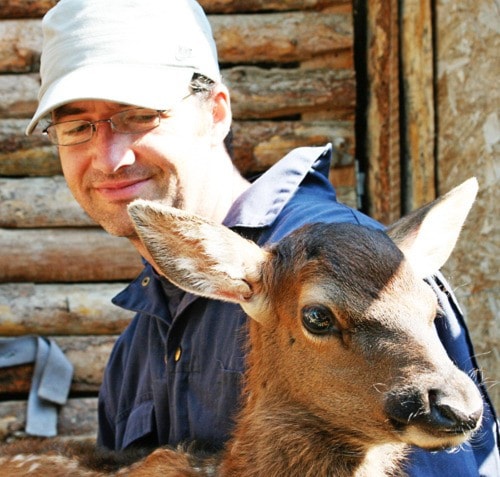By Annalee Grant
Townsman staff
She’s furry, covered in polka dots and has a new lease on life thanks to a bunch of helpful human friends.
A female elk calf was found in, appropriately so, the Elk River near Fernie in late June. The calf, nicknamed River, was rescued by local conservation officers, who brought the struggling baby to Barely Making It Wildlife Rescue and Rehab in Jaffray. She was suffering from tendon damage on her rear leg, after being thrashed around in the high water.
Wendy Smith of Barely Making It decided the little calf could be easily rehabilitated, and so the recovery effort began.
“Her leg was cut up, but it didn’t look like it was going to be too bad,” she said.
The calf was brought to Steeples Veterinary Clinic where they cleaned and disinfected the wound. Smith said the staff at the clinic gave up their lunch hours to help out the difficult patient. The leg was splinted and wrapped.
After leaving the clinic, Smith has had her neighbours and friends help out with the cleaning of the wound. Because the elk is still very wild, she cannot be restrained.
“You can’t tie her up because she’s a wild animal,” she said.
River is friendly towards Smith and her daughter, because they bring her food and have been bottle nursing her back to health.
“We’re her mom because we bottle feed her,” Smith said.
But other than that, the calf remains wild. She is being housed with several stray deer fawns, and is getting along just fine with them. River’s fawn-mates include white tailed and mule deer.
“Everybody gets along,” Smith said. Because the animals often come to Barely Making It very young, they do not know any different beyond their home with other animals.
The dressing on the wound had to be changed twice a day in the beginning, to prevent the massive infection from getting worse. Smith said she expects River to be out of the woods this week, and is happy to report the calf is beginning to walk on the damaged leg.
“We are assuming that everything is going to be fine when we take the splint off,” she said. That milestone was expected to happen this week.
River will remain in Smith’s care for about nine months and will be returned to the wild in the spring. She doesn’t release any animals until then because they may not survive the winter. Under her license with the province, Smith can keep wild animals for no more than nine months.
“They don’t have a wild mom to show them,” Smith said. “They have a very much better survival rate (in the spring).”
The animals are released at an undisclosed location far away from human activity.
An elk isn’t the strangest wild animal Smith has had on her hands. She has also taken in moose and has many birds.
“I don’t know what I don’t take in,” Smith laughed.
She will however, send predators like bears or wild cats on to those better equipped to rehabilitate them.
“I just don’t have the facilities,” she said. “You would have to have a very secure wire cage.”
When those larger, more dangerous animals do come in, Smith stabilizes them before shipping them off to another rescue facility capable of having larger animals. She has fostered a lynx kitten before.
After the severe wind storm that hit the area July 20, Smith said she had a neighbour bring in a nest full of Northern Flicker chicks whose tree had been knocked over. They survived the tumble and are now being rehabilitated at Barely Making It.
She has also taken in baby deer from Kimberley who were orphaned when their mom had to be euthanized for aggressive behaviour. Smith said she keeps things in perspective, and does not take in any animals that are not capable of rehabilitation. She works with Steeples to determine if an animal is too ill to treat.
“We have to be realistic,” she said.
Smith also has a great relationship with area conservation officers, who bring her animals, like the recent elk calf. She became licensed to be a wildlife rehab centre 12 years ago.
When she runs out of space or has too many animals to work with, Smith said she’ll share between nearby shelters. She recently sent four fawns up to a Nelson sanctuary, bringing her tally down to five.
“(It was) a little much,” she said of the nine babies.
